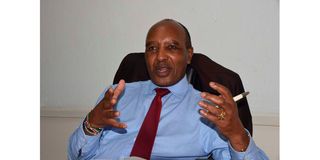Nyandarua County tops in wealth creation

Nyandarua Governor Francis Kimemia during his interview with the Sunday Nation on October 4, 2021.
Nyandarua County created wealth at a faster rate than any other devolved unit between 2013 and 2020, as its contribution to the country’s gross domestic product (GDP) showed the most consistent and highest growth rate in the eight years.
Meru and Elgeyo Marakwet also fell in the category of most improved counties as measured by their contribution to the country’s national wealth, according to the third edition of the Commission on Revenue Allocation (CRA) county fact sheet.
At a time when most counties were showing decline in generating wealth, the three devolved units displayed consistent growth in their contribution to GDP.
Nyandarua, Meru and Elgeyo Marakwet are led by governors Francis Kimemia, Kiraitu Murungi and Alex Tolgos respectively.
Overall, however, Nairobi, Kiambu, Mombasa, Nakuru and Meru were the highest contributors to the country’s Gross Domestic Product.
Nairobi, led by Governor Ann Kananu, has retained the leading position over the years since the advent of devolution.
The country’s administrative capital contributes nearly one third of Kenya’s gross domestic product (GDP), at 26.9 per cent.
It is followed by Kiambu at 5.59 per cent and Mombasa, under Governor Hassan Joho, which contributed 4.72 per cent to the national cake.
The report says the dominant economic activities in Mombasa and Nairobi are transport and storage, finance and insurance services respectively unlike in the 45 other counties where leading economic activities are agriculture, forestry and fishing.
At the advent of devolution in 2013, Nyandarua County’s contribution to Kenya’s GDP stood at 1.03 per cent. This has increased to 1.52 per cent, an increase of 0.49 percentage point.
Meru County’s contribution has risen from 3.04 per cent to 3.49 per cent, representing a jump of 0.45 percentage point. Elgeyo Marakwet, meanwhile, grew its GDP contribution from 0.76 per cent in 2013 to 1.18 per cent.
Even though Nairobi retains the top position in absolute figures, its contribution to the country’s wealth has dropped from 27.5 per cent in 2013 to 26.99 by 2020. This could be as a result of other counties making significant investments that are increasing their contribution.
The biggest decline has, however, occurred in Mombasa County whose contribution dropped by nearly a full percentage point from 5.55 per cent in 2013 to 4.72 per cent. Machakos County’s contribution also fell by 0.72 percentage points from 3.89 per cent in 2013 to 3.17 per ent in 2020.
Nairobi’s gross county product (GCP) contribution to the total economy’s gross value added (GVA) doubled from Sh1.3 trillion to Sh2.6 trillion in the period.
Growth in GCP indicates improvement in counties’ productivity and wealth creation, a sign of economic recovery.
Kiambu, which is the second biggest, grew from Sh288.9 billion to Sh553.3 billion, Nakuru from Sh221 billion to Sh480 billion and Mombasa from Sh268 billion to Sh467 billion.
According to the CRA data, Nairobi, Kiambu, Mombasa, Nakuru, and Meru combined, the top five counties, contributed 46.9 per cent of total wealth created by the 47 counties, with the top 10 contributing about 60 per cent of the national wealth.
On the other hand, the 10 poorest counties, mostly classified as arid and semi-arid lands (Asals), contributed a paltry 4.6 per cent.
Isiolo, Samburu, Tana River, Lamu and Wajir contributed the least to the country’s economy at Sh26 billion, Sh29.2 billion, Sh29.8 billion, Sh32 billion and Sh49 billion in the period under review.
The main economic activity in these counties is livestock rearing. The CRA report classifies livestock production as insignificant compared to other sectors such as agriculture and manufacturing.
“It is the expectation of the commission that policymakers will use these fact sheets to formulate policy. More importantly, the commission hopes that citizens will use the third edition of the county fact sheets to hold their leaders accountable. An informed citizen is the best auditor,” CRA chairperson, Dr Jane Kiringai, stated.
Counties so far have utilised revenue totalling Sh3.2 trillion. Out of this amount, Sh2.5 trillion is equitable share, Sh142 billion conditional grants from the national government, Sh191 billion loans and grants from donors and Sh271 billion from own-source revenue collection.
The counties’ equitable share has increased from Sh190 billion in the 2014/14 financial year to Sh370 billion in the current financial year of 2021/22.
Touted as the backbone of the economy, agriculture is now being cited as a contributor to poor revenue collection in the counties over the past six years. The report links counties’ over-reliance on agriculture to revenue under-performance, meaning most Kenyans are only undertaking subsistence agriculture that does not translate to economic growth.
In terms of own source revenue, Nairobi County has generated nearly four times as much as Mombasa, which follows, since 2013. The capital city has raised Sh83.2 billion, Mombasa (Sh23.8 billion), Kiambu (Sh17.2 billion), Nakuru (Sh17.1 billion) and Narok (Sh14.7 billion).
On the opposite end, Tana River (Sh0.4 billion), Lamu (Sh0.6 billion), Wajir (Sh0.6 billion), West Pokot (Sh0.7 billion) and Mandera (Sh0.7 billion) have generated the least revenues on their own between 2013 and 2020.






